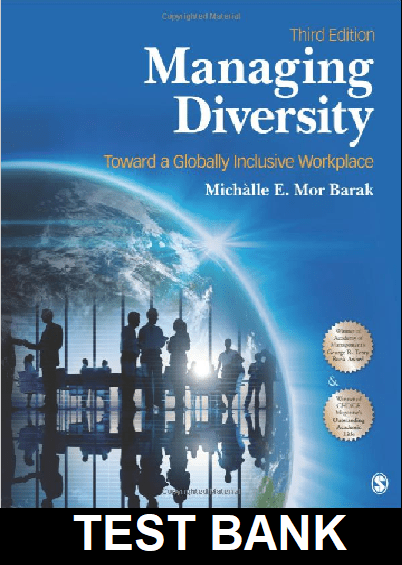Description
Managing Diversity 3rd Edition By Barak – Test Bank
Chapter 5: Socioeconomic Transitions: The New Realities of the Global Workforce
Multiple Choice
- Migration of working-age people has traditionally contributed to __________ such imbalances in labor demand and supply, and is still a solution for many in developing countries.
- Exacerbating
- Resolving
- Questioning
- Perpetuating
Ans: B
Page: 99
- Migration of workers or migration of employers, and the resulting encounter of people from different places with different cultures and capabilities, is an important contributor to _______________.
- Socioeconomic Diversity
- Gender Diversity
- Age Diversity
- Workplace Diversity
Ans: D
Page: 100
- International migrants tend to head for countries with which they share
- Traditional relationships
- Historic relationships
- Geographic proximity
- All of the above
Ans: D
Page: 101
- Globalization is allowing countries to _________ many of their employers, particularly those in labor-intensive, low-paying industries that make a transportable product.
- Retain
- Import
- Export
- Retire early
Ans: C
Page: 100
- The proportion of foreign or foreign-born workers grew in European countries that are primary destinations for people from neighboring countries in _____________.
- Asia
- Eastern Europe
- United Nations
- All of the above
Ans: B
Page: 102
- Which oil rich, labor-poor regions have been the most notable recipients of worker migrants, especially from a wide range of Asian countries?
- South Africa
- Middle East
- Southeast Asia
- European Union
Ans: B
Page: 103
- Population trends are making culturally based workforce diversity a fact of life for virtually all _______________.
- Undeveloped Countries
- Developed Countries
- Countries in Europe
- All of the above
Ans: B
Page: 101
- The occupational patterning of migrants is _________ in broad categories if both sides of the migration equation are considered.
- Predictable
- Unpredictable
- Easily tracked
- Never easily tracked
Ans: A
Page: 104
- Jobs that are _____ paying and ____ status in an industrialized country can be exported as _____ paying and _____ status to developing companies.
- Low; Low; High; High
- Low; High; Low; High
- High; Low; High; Low
- High; High; Low; Low
Ans: A
Page: 100
- The United Nations estimated that between 2005 and 2010 for the first time the growth rate of the migrant stock (meaning all migrants, not just workers) for less-developed regions ____________ the rate for more-developed regions.
- Equaled
- Surpassed
- Fell behind
- Quadrupled
Ans: B
Page: 103
- _______________ within the European Union (EU) is relatively low, as evidenced by the general reluctance of most people to migrate for work, given alternative, albeit less attractive opportunities at home.
- Inter-country mobility
- Cross-border mobility
- Full-time employment
- Two-job employment
Ans: B
Page: 102

Reviews
There are no reviews yet.